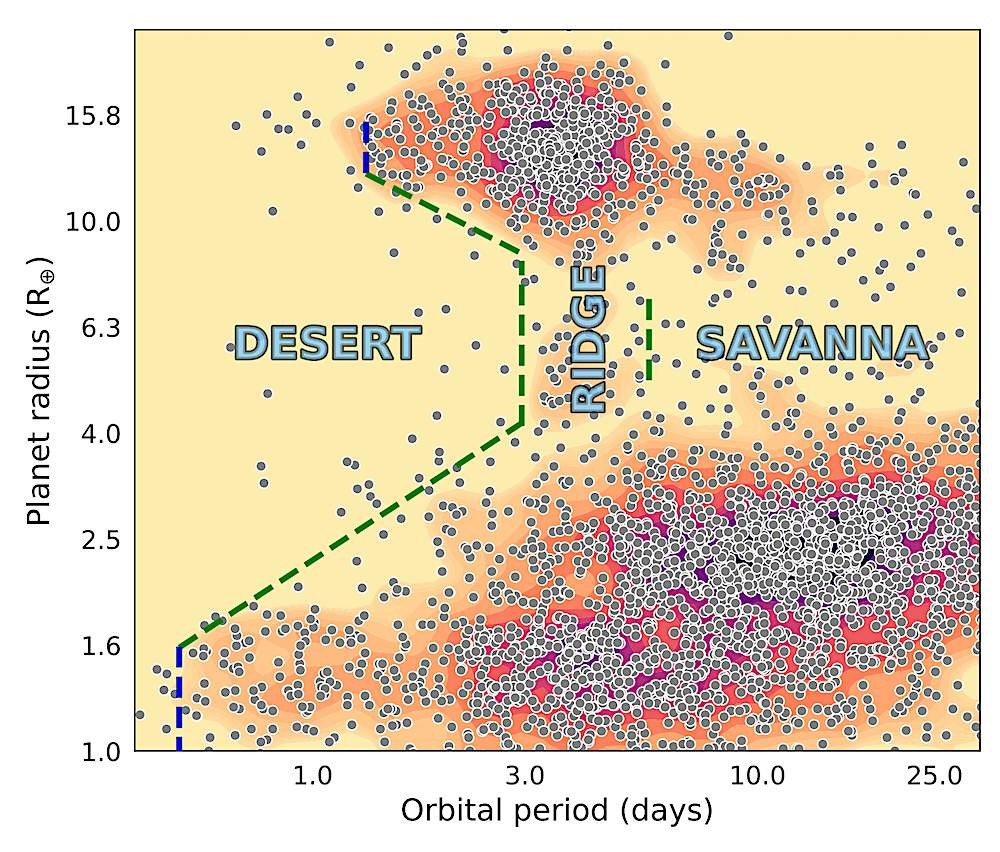John Carlos Baez on Nostr: 𝗧𝗛𝗘 𝗡𝗘𝗣𝗧𝗨𝗡𝗜𝗔𝗡 𝗗𝗘𝗦𝗘𝗥𝗧 Once we ...
𝗧𝗛𝗘 𝗡𝗘𝗣𝗧𝗨𝗡𝗜𝗔𝗡 𝗗𝗘𝗦𝗘𝗥𝗧
Once we knew just one solar system. Now we can see 𝘩𝘶𝘯𝘥𝘳𝘦𝘥𝘴 of solar systems and learn how they work on average! We are learning amazing things, like this:
Here's a chart showing planets whose year is 25 Earth days long or less. These planets are very close to their suns. There's a big blob of planets with mass 10-20 times the Earth's mass, whose year is just 1-10 days long! These are called 𝗵𝗼𝘁 𝗡𝗲𝗽𝘁𝘂𝗻𝗲𝘀.
But there's an interesting shortage of slightly less massive planets that are quite close to their sun. This is called the 𝗡𝗲𝗽𝘁𝘂𝗻𝗶𝗮𝗻 𝗱𝗲𝘀𝗲𝗿𝘁. And there's another less dramatic shortage of planets in the 𝗡𝗲𝗽𝘁𝘂𝗻𝗶𝗮𝗻 𝘀𝗮𝘃𝗮𝗻𝗻𝗮. Both these need to be explained.
Now we have a new clue. This September astronomers discovered that the desert and savanna are separated by a region with more planets, which they call the 𝗡𝗲𝗽𝘁𝘂𝗻𝗶𝗮𝗻 𝗿𝗶𝗱𝗴𝗲.
What does it all mean? There are lots of theories, but it will take a while to figure it out.
Here's the new paper:
• A. Castro-González, V. Bourrier, J. Lillo-Box, J.-B. Delisle, D. J. Armstrong, D. Barrado and A. C. M. Correia, Mapping the exo-Neptunian landscape: a ridge between the desert and savanna,
https://arxiv.org/abs/2409.10517.
With all this work we need to think about 'selection bias': some planets are easier to see than others, so what we see is not the same as the real situation! So, a lot of this paper is about compensating for selection bias.
For a link to a gentler, less technical article, read on.
(1/2)

Published at
2024-10-03 17:14:10Event JSON
{
"id": "fa9437e2edfc0afbd69b9633a91e8edc9b7bb68ecdb0e6fe42e8f2cf2956c7df",
"pubkey": "f7346eb283902ada9d21c109a93e83128d9f87d8fcfe70ad819b3bf2ad9bce16",
"created_at": 1727975650,
"kind": 1,
"tags": [
[
"proxy",
"https://mathstodon.xyz/users/johncarlosbaez/statuses/113244612199214496",
"activitypub"
]
],
"content": "𝗧𝗛𝗘 𝗡𝗘𝗣𝗧𝗨𝗡𝗜𝗔𝗡 𝗗𝗘𝗦𝗘𝗥𝗧 \n\nOnce we knew just one solar system. Now we can see 𝘩𝘶𝘯𝘥𝘳𝘦𝘥𝘴 of solar systems and learn how they work on average! We are learning amazing things, like this:\n\nHere's a chart showing planets whose year is 25 Earth days long or less. These planets are very close to their suns. There's a big blob of planets with mass 10-20 times the Earth's mass, whose year is just 1-10 days long! These are called 𝗵𝗼𝘁 𝗡𝗲𝗽𝘁𝘂𝗻𝗲𝘀. \n\nBut there's an interesting shortage of slightly less massive planets that are quite close to their sun. This is called the 𝗡𝗲𝗽𝘁𝘂𝗻𝗶𝗮𝗻 𝗱𝗲𝘀𝗲𝗿𝘁. And there's another less dramatic shortage of planets in the 𝗡𝗲𝗽𝘁𝘂𝗻𝗶𝗮𝗻 𝘀𝗮𝘃𝗮𝗻𝗻𝗮. Both these need to be explained.\n\nNow we have a new clue. This September astronomers discovered that the desert and savanna are separated by a region with more planets, which they call the 𝗡𝗲𝗽𝘁𝘂𝗻𝗶𝗮𝗻 𝗿𝗶𝗱𝗴𝗲.\n\nWhat does it all mean? There are lots of theories, but it will take a while to figure it out.\n\nHere's the new paper:\n\n• A. Castro-González, V. Bourrier, J. Lillo-Box, J.-B. Delisle, D. J. Armstrong, D. Barrado and A. C. M. Correia, Mapping the exo-Neptunian landscape: a ridge between the desert and savanna, https://arxiv.org/abs/2409.10517.\n\nWith all this work we need to think about 'selection bias': some planets are easier to see than others, so what we see is not the same as the real situation! So, a lot of this paper is about compensating for selection bias.\n\nFor a link to a gentler, less technical article, read on.\n\n(1/2)\n\nhttps://media.mathstodon.xyz/media_attachments/files/113/244/496/342/306/359/original/8a986be8fc9391fa.jpg",
"sig": "987935d62f36fa0a46ab29d1d4df548c074e486c9cc283f00a0b87b2214073cdc08242890f350debd4bfdd38f84e26064e115c05e3260cf4d696002a4d3e9dfd"
}
